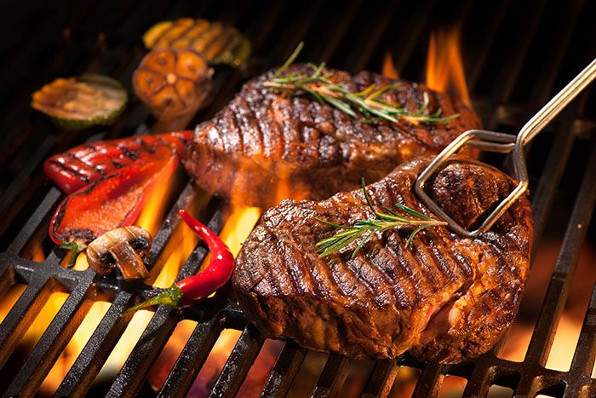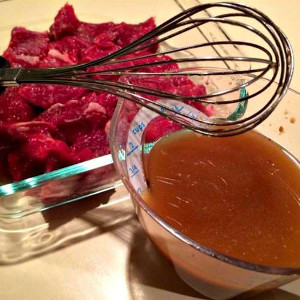The summer grilling season is ramping up to full steam (or smoke, if you will) in spite of the continuing COVID-19 crisis. And that’s reigniting the annual bonfire of questions from readers about how to get the most for their grilling bucks. Herewith, then, a simple rundown/refresher…
 Perfect Steaks on a perfect Grill: Your ultimate goal!
Perfect Steaks on a perfect Grill: Your ultimate goal!
An unprecedented ‘multi-whammy’
Beef has been hit with multiple whammies this spring and summer, as the COVID-19 pandemic continues on its majestic and implacable course.
First, it was shortages in some places after packing house workers started testing positive for the coronavirus by the hundreds, and a number of key plants had to shut down for rafter-to-floor drain clean downs.
Then farmers had to cull their herds due to a surplus of Beef on the hoof that the plants weren’t buying.
At this point, the Beef production and supply chain remains in a tizzy that’s resulted in protracted price increases – some due simply to abiding uncertainty about what’s going on in the business.
The most remarkable aspect of this whole scenario is, dedicated grillers have not let up on their demand for their favourite grilling Protein: Beef Steak cuts, regardless of price or availability. So it should come as no surprise that grillers want to make the most of their ‘investment’.
Get the right cut(s)
The best grilling cuts – as most grillers already know – are those that are cut across the grain of the meat, rather than along the grain (with some exceptions; see below). Most folks expect their T-Bones, Rib Eyes, Strip Loins and other popular cuts to cook up tender and juicy, and many grilling aficionados have their own pet procedures, marinades and so on to ensure that they’ll reach that hallowed goal.
If you love a Southwestern or Tex-Mex grill, Flank, Skirt, Hanger and Flat Iron Steak are all great choices. These are similar looking cuts from different parts of the cow that all share one important structural characteristic: They are flat, and are cut with/along the grain of the meat. They are typically very flavourful but can only be rendered tender for eating by slicing them thinly across the grain after cooking them in one large piece. These are the traditional cuts used for Fajitas and other dishes (particularly Asian!) that call for thin strips of Beef. They’ll benefit from marinating, but not from tenderizing.
For newcomers to the art and craft of grilling, the first rule when shopping for the meat is to choose the right grade. Canada grades Prime and AAA / US Select or Prime boast the most abundant and most evenly distributed marbling would be the best choice, but they’re also the most expensive. Without sufficient ingrained Fat – referred to in the biz as ‘marbling’ – the meat can’t help but come out tight, dry and less flavourful than you’d expect or desire. But if you can’t justify laying out Prime bucks for Prime cuts, don’t despair.
Marinating and tenderizing
Marinating (see photo, top of page) and tenderizing are not the same thing. Marinating does not tenderize; it only imparts flavours to the meat. Tenderizing can be combined with marination or administered separately, but it’s a separate set of mechanical and chemical operations.
For those who don’t want to add chemical additives to their food, the good news is, the most effective agents for tenderizing Beef are naturally-sourced. The most notable is the enzyme Papain, which soaks into the meat and breaks down the proteins. You can get pure Papain at the grocery store or meat market, but follow the instructions carefully. Use too much and your expensive meat cuts will emerge from their tenderizing bath slimy or – worse – mushy. The best course of action is to add pure, fresh Papaya or Pineapple Fruit or Juice to in your marinade of choice. That makes it harder to overdose your meat and allows the marinade to penetrate the meat better.
Alternate tenderizing methods
If you prefer, you can use a meat hammer to beat an under-marbled, more economical Steak to mechanically break down the fibres. Again, the flavours of any marinade you add after that will penetrate the meat more efficiently. But that doesn’t make up for a lack of marbling.
Fortunately, you can compensate for a lack of marbling in several ways. The most popular one is to wrap your meat in strips of Fat or Fatty meat. Who hasn’t had a Bacon-wrapped Filet Mignon? The Filet is one of the leanest cuts on the cow, but, paradoxically, is one of the most expensive. That Bacon strip isn’t there primarily for the flavour, though it does add some lovely, smoky flavour and aroma. This practice is officially referred to in haute cuisine circles as ‘Barding’.
If you’re serious about compensating for a lack of marbling in a thick Steak, do what the French do: get a Larding Needle and ‘sew’ a grid of thin Fat Strips through the meat emulating nice, even marbling. That way, you get the benefits of marbling (flavour and texture) and save some cash. You simply make up in time and effort what you save in cash.
Tip: Piercing the meat can allow larding or barding Fat to more easily penetrate the meat, bestowing both flavour and texture benefits.
Marinating tips…
I address your attention at this time to a ‘legacy’ post on marinating from a grilling season gone by.
As with all things that combine art and science…
Prepping and Grilling Beef for optimal results is an activity the results of which only improve with experience. ‘Do the doing’ and the accolades will just naturally follow in good time…
~ Maggie J.

